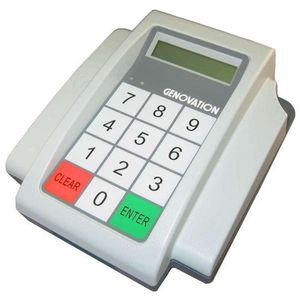The Genovation MiniTerm 905 is a fully programmable LCD mini-terminal. The Mini Data Terminal supports simple and complex re-programmable key macros and system configurations. It includes detachable serial (RS232) and USB cables for easy setup and flexibility. The 905 has multiple card/tag reader options for fast and easy data transactions. The LCD can also be used as a customer display (pole display).
Genovation's MiniTerms are ideal whenever you need to add a user interface to a machine, device or process. The possibilities are endless -- MiniTerms are right at home whether connected to PCs, printers, automation or industrial control PLC systems, cash registers or other POS terminals, electronic musical instruments, high-speed video cameras, security systems, CNC mill control and industrial pendants, access control systems and digital signage -- just to name a few. Genovation™
Installation and Setup
Step 1: Download and Install the Driver
- Go to the Genovation website and scroll down to Driver/Software. Click on the latest driver.
- Open the file and click Run.
- It is recommended you close all other applications. When you have done so, click Next.
- If you would like to save the file in a different location other than indicated, click the Browse button and set the new location. When you are done, click the Next button.
- Drivers, Help Files and Test Programs should be selected for installation. This requires at least 7.2 MB of space. Click Next to continue.
- If you would like to save the program shortcut in a different location other than indicated, click the Browse button and set the new location. When you are done, click the Next button.
- Click the Install button to begin installing the Genovation device on your computer.
The Windows command window will appear as the installation process runs. A warning may pop-up in another window asking if you are sure you wish to continue with installation. If you have downloaded the driver from the website indicated above, select to continue with installation.
- If you do not wish to launch the device at this point, uncheck Launch Genovation MiniTermPro. Complete the installation process by clicking Finish.
Step 2: Connect the pinpad device.
Step 3: Locate the Correct Port Number
- Determine which port the scanner is using.
- Click on the Start button from your computer.
- Locate and click on the Control Panel in the menu.
- Locate the Hardware settings and click on the title.
- In the Hardware and Sound window, locate Devices and Printers and click on Device Manager.
- In the Device Manager window, locate Ports (COM & LPT). Click on the right-facing arrow to expand Ports and view port devices.
- Locate the Genovation device and take note of the COM number.
Step 4: Download the → Lunchbox.xml file.
Step 5: Set-up the device
- Login to Newton.
- Locate and click on the Administration and Maintenance tab.
- Locate the Serving Line option in the Point-of-Sale Setup ribbon.
- Select either Serving Lines or Serving Line Configs depending on if your District uses line or a particular template. If you are unsure, check with your point of contact in the District.
Step 5: Configure the Device in Newton
Step 5 includes instructions for both Serving Line and Serving Line Configs. Choose the correct section your District utilizes for setup.
- Serving Line - Click on the Serving Line option.
- In the Serving-Line Maintenance window, select a cafeteria line by clicking on a row or using the drop-down arrow and click the Edit button. If you use the drop-down arrow, be sure to select the proper serving line to install the device.
- Scroll down and locate the Devices section in the parameters.
- Once you have located the Devices section click on Customer Input Device #1, then the ellipsis button.
Use











